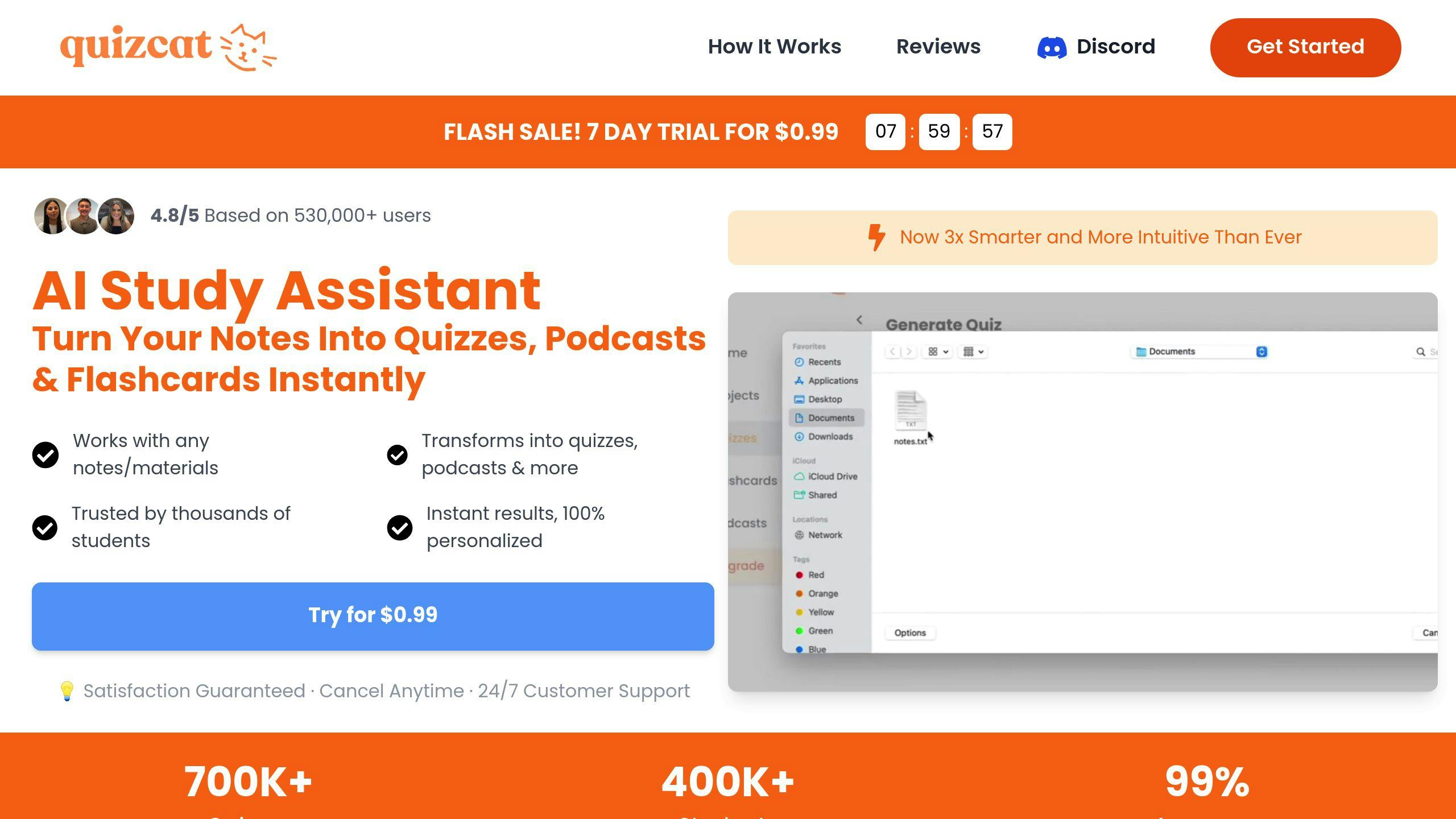
How AI Personalizes Feedback for Better Learning
AI is transforming education by providing instant, personalized feedback to students, helping them improve faster and more effectively. Traditional feedback methods often lack scalability and timeliness, but AI tools solve these challenges by analyzing student performance, identifying gaps, and offering tailored guidance in real-time. Here's what you need to know:
- Why Feedback Matters: It helps students identify strengths and weaknesses, improving learning outcomes.
- Challenges with Traditional Feedback: Limited time, scalability, and delayed responses reduce its impact.
- How AI Helps:
- Uses tools like natural language processing and progress tracking.
- Provides instant, adaptive feedback tailored to individual needs.
- Platforms like QuizCat AI adjust difficulty based on performance.
AI feedback systems save time, reduce stress, and improve learning by offering clear, actionable insights students can apply immediately. With advancements in tools and research, AI is reshaping education to make personalized learning accessible and effective for all.
How one school is using AI to give their students feedback
How AI Improves Feedback Delivery
AI is transforming how feedback is delivered, offering instant, tailored guidance that adjusts to each student's specific needs.
AI Feedback Mechanisms
AI uses several methods to analyze student performance and provide precise feedback:
| Mechanism | Purpose |
|---|---|
| Natural Language Processing | Examines responses to pinpoint areas for improvement |
| Progress Tracking | Observes learning trends to refine strategies |
| Knowledge Gap Analysis | Assesses understanding to address weaker areas |
These systems continuously learn from each interaction, improving the accuracy and relevance of feedback over time.
Generative AI in Education
Generative AI takes feedback a step further by mimicking teacher-student interactions. It provides detailed, conversational responses that evaluate specific aspects of a student's work, making the guidance feel more engaging and personal [1].
"The future of AI-enabled individualized education opens up a range of possibilities, including further advancements in adaptive learning and predictive analytics" [3].
Tools like QuizCat AI bring this technology to classrooms, offering students an interactive way to receive personalized feedback.
Case Example: QuizCat AI

QuizCat AI showcases how AI-powered feedback is reshaping education. By analyzing uploaded materials, it generates custom quizzes, flashcards, and even podcasts. Feedback is instant, and the difficulty adjusts based on student performance, ensuring focused improvement. A Stanford-led study published in May 2023 in Educational Evaluation and Policy Analysis supports this approach, showing that automated feedback tools boost both student engagement and assignment completion rates [4].
Using AI Feedback in Education
Effectively incorporating AI feedback into education means blending technology with established teaching methods. Both students and educators need thoughtful strategies to make the most out of these tools for personalized learning experiences.
Tips for Using AI in Learning
To get the best results from AI tools, it's important to set clear objectives and regularly track progress. Here are some practical ways to use AI feedback effectively:
| Strategy | Implementation | Expected Outcome |
|---|---|---|
| Set Goals and Monitor | Define specific objectives and review progress weekly using AI tools | Improved focus and early identification of gaps |
| Apply Feedback | Act on AI-generated insights without delay | Better understanding and retention |
| Adapt Learning | Adjust study plans based on AI recommendations | More efficient and tailored learning |
Students who regularly review and act on AI feedback often see better results, especially when they follow a structured plan for applying suggestions.
Examples and Research on AI Feedback
Research underscores how AI feedback is reshaping education. For example, a study led by Stanford found that automated feedback tools significantly boosted student engagement and learning outcomes [4].
Here are some real-world examples of AI feedback in action:
- Coursera's AI System: Coursera uses AI to create personalized learning paths tailored to each student's progress and career goals. This approach has led to higher course completion rates and increased satisfaction among learners [5].
- QuizCat AI's Model: QuizCat AI showcases how personalized feedback can drive measurable learning improvements. Their platform highlights the potential for scaling individualized feedback while maintaining strong educational results.
These examples demonstrate that when used effectively, AI feedback can provide immediate, tailored guidance, helping students achieve better outcomes in their educational journey.
sbb-itb-1e479da
Advantages of Personalized Feedback for Students
AI-powered feedback systems are changing the way students learn, offering tailored insights that match individual needs and learning styles. These systems provide a more focused and efficient learning experience.
Let’s dive into how AI feedback can directly improve students’ learning strategies and outcomes.
Better Self-Awareness and Targeted Focus
AI feedback helps students understand their strengths and weaknesses by identifying gaps and tracking progress in real time. This allows students to concentrate on areas that need improvement, leading to more effective study habits and results.
For example, tools like DreamBox adjust content automatically based on a student's specific learning needs, helping them adopt smarter strategies for improvement [5].
Convenience and Time-Saving Benefits
AI tools such as Gradescope deliver instant feedback, helping students quickly correct mistakes and stay on track. This makes study sessions more productive by focusing on what matters most.
By offering immediate and personalized insights, AI feedback systems ensure students get guidance tailored to their needs. This approach not only saves time but also reduces stress, creating a more flexible and efficient learning process.
"Research indicates that personalized feedback, facilitated by AI tools, enhances academic performance and retention rates by keeping students engaged and motivated" [6][2].
These advancements highlight how AI is reshaping education, making learning more effective and accessible for students everywhere.
Conclusion: The Future of AI in Personalized Learning
Main Points
AI-driven feedback systems are changing the way education works by offering tailored learning experiences that are both accessible and impactful. Research highlights a 62% boost in test scores through adaptive learning programs [3].
Platforms like QuizCat AI showcase how AI can turn study materials into customized learning tools, pinpointing areas where students need the most help. These systems are now capable of providing guidance with 91% accuracy, effectively identifying and addressing individual learning needs [3]. This level of precision, paired with the ability to scale for large groups, highlights the undeniable impact AI is having on education.
With these tools already influencing classrooms, the potential for even more advanced AI applications in education is immense.
Future Prospects
Looking ahead, advancements in AI are set to further reshape personalized learning. The global AI in education market is expected to grow at an annual rate of 36.0% between 2022 and 2023 [3].
"AI can help improve the way instructors engage with their students, by way of a cutting-edge tool that provides feedback on their interactions in class." - Stanford Report, 2023 [4]
Emerging technologies like enhanced natural language processing, predictive analytics, and real-time translation will refine feedback, detect challenges earlier, and expand access to education worldwide. Integrating AI into platforms like Canvas demonstrates how these tools are already making a difference for both students and educators [2].
As AI continues to evolve, it promises to make high-quality education more accessible and effective for learners everywhere.
FAQs
Can you use AI for feedback?
Absolutely. AI is a powerful tool for providing tailored feedback in education. By analyzing student work, it offers clear, actionable guidance to help learners address gaps in their understanding. Studies highlight its usefulness, especially in large-scale educational settings where traditional feedback methods may not suffice.
Here’s how AI feedback operates:
| Feedback Type | How It Works | Benefits |
|---|---|---|
| Dynamic Feedback | Tracks performance, adjusts difficulty, and offers real-time guidance | Helps students make quick corrections and follow personalized learning paths |
| Comprehensive Assessment | Evaluates work to pinpoint strengths and weaknesses | Provides detailed insights for improvement |
AI feedback shines in areas like language learning, where it can deliver precise written evaluations and improvement suggestions. These systems are scalable, ensuring consistent feedback quality for a large number of learners.
For example, platforms like QuizCat AI showcase this in action by offering instant quiz feedback and adaptive learning paths. The tool evaluates student answers and adjusts content difficulty to support continuous progress [1][2].
